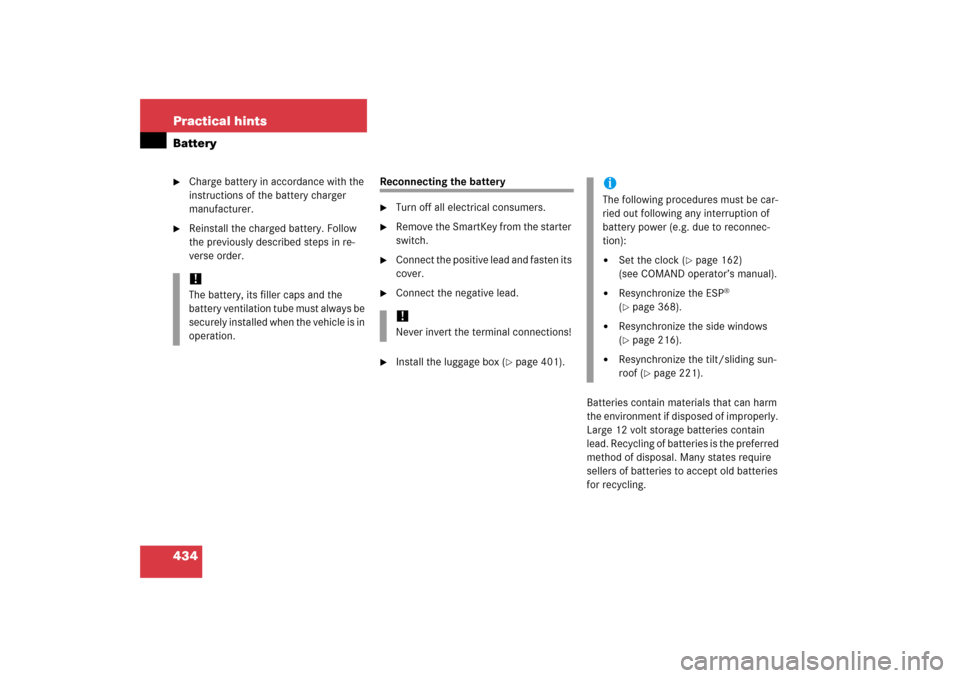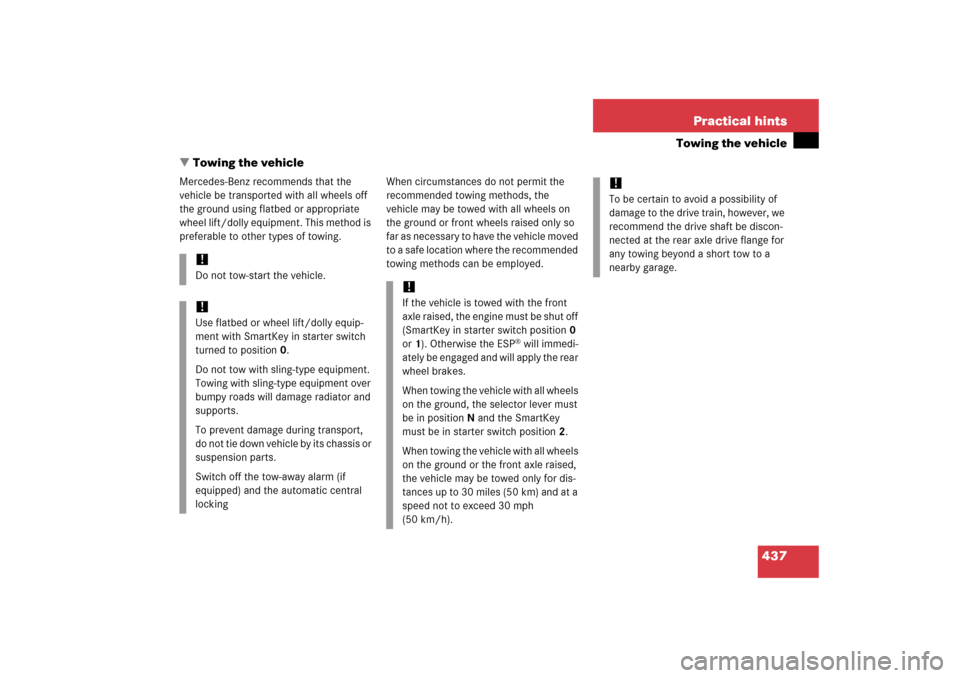Page 431 of 498

430 Practical hintsFlat tireWarning!
G
In emergency mode, your vehicle’s driving
characteristics are diminished in such situa-
tions as:�
driving around curves
�
while braking
�
while accelerating rapidly
Therefore, your driving style must be adapt-
ed accordingly. Avoid abrupt steering and
driving maneuvers, as well as driving over
obstacles (road curbs, potholes, or off-road
areas). This is especially important if the
vehicle is heavily loaded.
The emergency driving distance that can be
achieved greatly depends on the demands
placed on the vehicle. Depending on speed,
load, driving maneuvers, road conditions,
outside temperature, etc., the distance can
be significantly shorter or, if the vehicle is
driven cautiously, somewhat longer.
Do not continue driving in emergency mode
if�
you notice knocking sounds
�
the vehicle starts to shake
�
smoke develops and you smell rubber
�
ESP
® is intervening continuously
�
you notice tears on the tire sidewalls
After driving in emergency mode, you must
have the rims inspected by an authorized
Mercedes-Benz Center to check if they are
suitable for further use. The failed tire must
be replaced in any case.iWhen replacing individual or all tires on
the vehicle, make sure only matching
tires marked with “MOExtended” are
mounted in the size specified for your
vehicle (
�page 456).
Page 435 of 498

434 Practical hintsBattery�
Charge battery in accordance with the
instructions of the battery charger
manufacturer.
�
Reinstall the charged battery. Follow
the previously described steps in re-
verse order.
Reconnecting the battery�
Turn off all electrical consumers.
�
Remove the SmartKey from the starter
switch.
�
Connect the positive lead and fasten its
cover.
�
Connect the negative lead.
�
Install the luggage box (
�page 401).
Batteries contain materials that can harm
the environment if disposed of improperly.
Large 12 volt storage batteries contain
lead. Recycling of batteries is the preferred
method of disposal. Many states require
sellers of batteries to accept old batteries
for recycling.
!The battery, its filler caps and the
battery ventilation tube must always be
securely installed when the vehicle is in
operation.
!Never invert the terminal connections!
iThe following procedures must be car-
ried out following any interruption of
battery power (e.g. due to reconnec-
tion):�
Set the clock (
�page 162)
(see COMAND operator’s manual).
�
Resynchronize the ESP
®
(
�page 368).
�
Resynchronize the side windows
(�page 216).
�
Resynchronize the tilt/sliding sun-
roof (
�page 221).
Page 438 of 498

437 Practical hints
Towing the vehicle
�Towing the vehicle
Mercedes-Benz recommends that the
vehicle be transported with all wheels off
the ground using flatbed or appropriate
wheel lift/dolly equipment. This method is
preferable to other types of towing.When circumstances do not permit the
recommended towing methods, the
vehicle may be towed with all wheels on
the ground or front wheels raised only so
far as necessary to have the vehicle moved
to a safe location where the recommended
towing methods can be employed.
!Do not tow-start the vehicle.!Use flatbed or wheel lift/dolly equip-
ment with SmartKey in starter switch
turned to position0.
Do not tow with sling-type equipment.
Towing with sling-type equipment over
bumpy roads will damage radiator and
supports.
To prevent damage during transport,
do not tie down vehicle by its chassis or
suspension parts.
Switch off the tow-away alarm (if
equipped) and the automatic central
locking
!If the vehicle is towed with the front
axle raised, the engine must be shut off
(SmartKey in starter switch position0
or1). Otherwise the ESP
® will immedi-
ately be engaged and will apply the rear
wheel brakes.
When towing the vehicle with all wheels
on the ground, the selector lever must
be in positionN and the SmartKey
must be in starter switch position2.
When towing the vehicle with all wheels
on the ground or the front axle raised,
the vehicle may be towed only for dis-
tances up to 30 miles (50 km) and at a
speed not to exceed 30 mph
(50 km/h).
!To be certain to avoid a possibility of
damage to the drive train, however, we
recommend the drive shaft be discon-
nected at the rear axle drive flange for
any towing beyond a short tow to a
nearby garage.
Page 449 of 498

448 Technical dataEngineModel
CLS 500 (219.375)
CLS 55 AMG (219.376
1)
1The quoted data apply only to the standard vehicle. See an authorized Mercedes-Benz Center for the corresponding data of all special bodies and special equipment.Engine
M113
M113
Mode of operation
4-stroke engine, gasoline injection
4-stroke engine, gasoline injection
No. of cylinders
8
8
Bore
3.82 in (97.00 mm)
3.82 in (97.00 mm)
Stroke
3.31 in (84.00 mm)
3.60 in (92.00 mm)
Total piston displacement
303.0 cu in (4 966 cm
3)
331.8 cu in (5 439 cm
3)
Compression ratio
10:1
9:1
Output acc. to SAE J 1349
302 hp/5 600 rpm
2
(225 kW/5 600 rpm)
469 hp/6 100 rpm
2
(350 kW/6 100 rpm)
2Premium fuel required. Performance may vary with fuel octane rating.Maximum torque acc. to SAE J 1349
339 lb-ft/2 700 rpm - 4 250 rpm
(460 Nm/2 700 rpm - 4 250 rpm)
516 lb-ft/2 650 rpm - 4 500 rpm
(700 Nm/2 650 rpm - 4 500 rpm)
Maximum engine speed
6300 rpm
6500 rpm
Firing order
1-5-4-2-6-3-7-8
1-5-4-2-6-3-7-8
Poly-V-belt
Belt one: 2 390 mm
Belt one: 1 289 mmBelt two: 2 449 mm
Page 450 of 498

449 Technical data
Rims and tires
�Rims and tires
!
Only use tires which have been tested
and approved by Mercedes-Benz. Tires
approved by Mercedes-Benz are devel-
oped to provide best possible perfor-
mance in conjunction with the driving
safety systems on your vehicle such as
ABS or ESP
®. Tires specially developed
for your vehicle and tested and ap-
proved by Mercedes-Benz can be iden-
tified by finding the following on the
tire’s sidewall:
�
MO = M
ercedes-Benz O
riginal
equipment tires
AMG vehicles:
Does not apply to all approved tires
on AMG vehicles. For information
on tested and approved tires for
AMG vehicles, contact an autho-
rized Mercedes-Benz Center.
�
MOE = M
ercedes-Benz O
riginal
E
xtended (tires with limited run-flat
characteristics) original equipment
tires
Using tires other than those approved
by Mercedes-Benz may result in dam-
age that is not covered by the
Mercedes-Benz Limited Warranty.iFor information on driving with
MOExtended tires, see
“MOExtendedsystem*” (
�page 321).
!Using tires other than those approved
by Mercedes-Benz can have detrimen-
tal effects, such as�
poor handling characteristics
�
increased noise
�
increased fuel consumption
Moreover, tires and rims not approved
by Mercedes-Benz may, under load,
exhibit dimensional variations and dif-
ferent tire deformation characteristics
that could cause them to come into
contact with the vehicle body or axle
parts. Damage to the tires or the vehi-
cle may be the result.
Page 462 of 498
461 Technical data
Fuels, coolants, lubricants etc.
�Fuels, coolants, lubricants etc.
CapacitiesVehicle components and their respective
lubricants must match. Therefore only use
products tested and approved by
Mercedes-Benz.Please refer to the Factory Approved Ser-
vice Products Pamphlet, or inquire at your
authorized Mercedes-Benz Center.
Model
Capacity
Fuels, coolants, lubricants etc.
Engine with oil filter
CLS 500
8.0 US qt (7.5 l)
Approved engine oils
CLS 55 AMG
9.0 US qt (8.5 l)
Automatic transmission
CLS 500
8.5 US qt (8.0 l)
MB Automatic Transmission Fluid
CLS 55 AMG
8.67 US qt (8.2 l)
Rear axle
1.37 US qt (1.3 l)
Hypoid gear oil SAE 85 W 90
Page 466 of 498

465 Technical data
Fuels, coolants, lubricants etc.
Premium unleaded gasoline
Gasoline additives
A major concern among engine manufac-
turers is carbon build-up caused by gaso-
line. Mercedes-Benz recommends only the
use of quality gasoline containing additives
that prevent the build-up of carbon depos-
its.
After an extended period of using fuels
without such additives, carbon deposits
can build up especially on the intake valves
and in the combustion area, leading to
engine performance problems such as:�
Warm-up hesitation
�
Unstable idle
�
Knocking/pinging
�
Misfire
�
Power loss
Warning!
G
Gasoline is highly flammable and poisonous.
It burns violently and can cause serious inju-
ry. Whenever you are around gasoline, avoid
inhaling fumes and skin contact, extinguish
all smoking materials. Never allow sparks,
flame or smoking materials near gasoline!
!To maintain the engine’s durability and
performance, premium unleaded gaso-
line must be used. If premium unleaded
gasoline is not available and low octane
fuel is used, follow these precautions:�
Have the fuel tank only partially
filled with unleaded regular and fill
up with premium unleaded as soon
as possible
�
Avoid full throttle driving and abrupt
acceleration
�
Do not exceed an engine speed of
3 000 rpm if the vehicle is loaded
with a light load such as two per-
sons and no luggage
�
Do not exceed
2/3 of maximum
accelerator pedal position if the
vehicle is fully loaded or operating
in mountainous terrain
Page 473 of 498

472 Technical termsBar
(
�page 332)
BAS
(Brake A
ssist S
ystem)
System for potentially reducing braking
distances in emergency braking situa-
tions. The system is activated when it
senses an emergency based on how
fast the brake is applied.
Bead
(
�page 332)
Bi-Xenon headlamps*
Headlamps which use an electric arc as
a light source and produce a more in-
tense light than filament headlamps.
Bi-Xenon headlamps produce low
beam and high beam.CAC
(C
ustomer A
ssistance C
enter)
Mercedes-Benz customer service
center which can help you with any
questions about your vehicle and pro-
vide assistance in the event of a break-
down.
CAN system
(C
ontroller A
rea N
etwork)
Data bus network serving to control
vehicle functions such as door locking
or windshield wiping.
Cockpit
All instruments, switches, buttons and
indicator/warning lamps in the passen-
ger compartment needed for vehicle
operation and monitoring.Cold tire inflation pressure
(
�page 332)
Collapsible tire
An especially compact spare tire that
must be inflated with a provided air
pump before using. It should only be
used to bring the vehicle to the nearest
service station.
COMAND
(Cockpit M
anagement and D
ata
System)
Information and operating center for
vehicle sound and communications
systems, including the radio and navi-
gation system, as well as other optional
equipment (CD changer, telephone,
etc.).